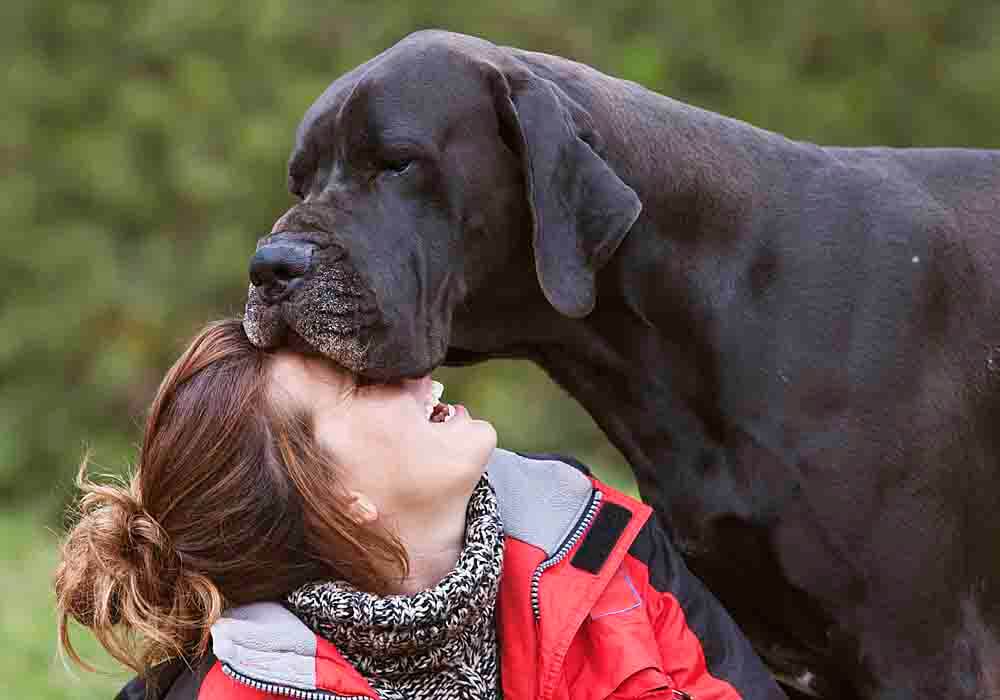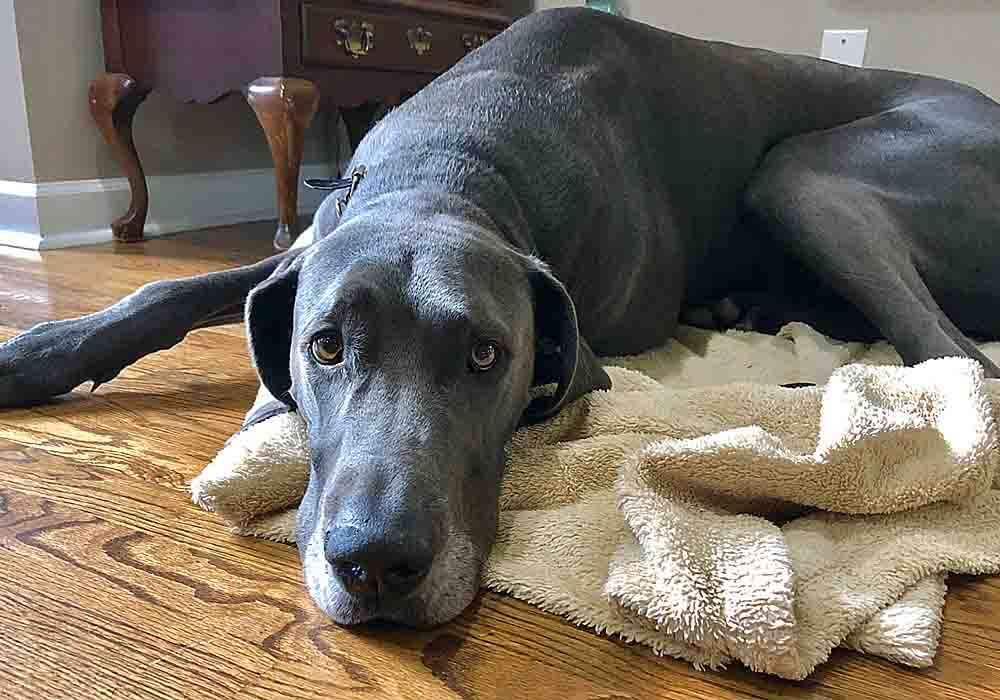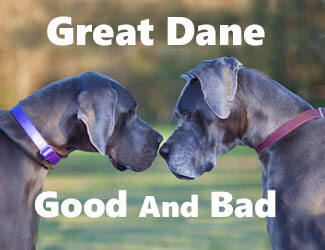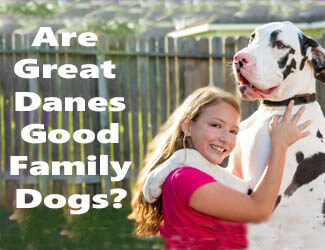Great Dane Basics
39 Top Questions Answered
by Ken Alden
Great Danes are certainly impressive animals. There’s something special about a sweet-tempered dog that’s as big as a small pony. But how much do you know about Great Danes?
Some Great Dane Basics...
Great Danes are easy-going, gentle giants who’ll only attack if threatened. They can get along well with people, including cats and other dogs. But they may drool excessively and have heart and joint problems. Contrary to popular belief, Danes don’t need a big yard; they can do well in apartments.
If you’re curious about Great Danes but may still need a little convincing, read on and learn more about what makes these overgrown puppies tick. In this article, I’ve scoured the Internet in search of answers to your questions about these Danes.
Pro-tip: Ever try lifting a Great Dane? Their weight can hurt not only your back but their joints when they hop down from cars, sofas or even your bed. To protect your back and theirs check out the best Mastiff ramps on Amazon.com now.
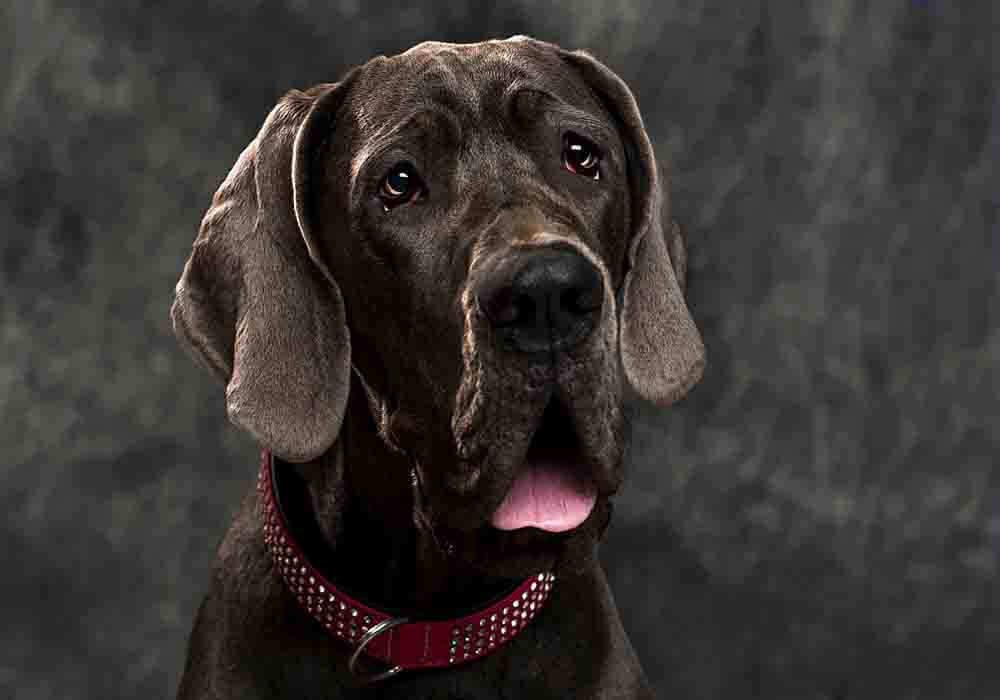
Do Great Danes Ever Calm Down?
If you own a Great Dane puppy, you’re probably wondering when they’ll finally settle down. Great Dane puppies have two speeds: asleep and full throttle. And when you have a curious, active 75-pound (34-kg) puppy, full throttle can result in lots of broken household items.
Fortunately, Great Danes will calm down eventually as they get older. The bad news is they’ll behave like a puppy until they’re at least two and possibly as old as 3 years old.
Do Great Danes Have a Lot of Health Problems?
Great Danes generally don’t live as long as smaller dogs, and you can expect them to live 8-10 years. Many die before that, though a few have lived for as long as 12-14 years.
Great Danes can have a lot of health problems and run into problems with gastric torsion or bloat, which is excruciatingly painful and can be fatal. To avoid bloat:
- Use elevated food dishes.
- Feed your Great Dane 2-3 small meals a day.
- Avoid exercising your Great Dane for at least an hour after eating.
Like many other large dogs, Great Danes can also be prone to hip dysplasia. They’ll need regular veterinary check-ups to ensure their hips and joints are in good condition, and all systems are running smoothly. Great Dane Basics
Read more about the Great Danes health issues from this page on our site.
Do Great Danes Need Their Ears Cropped?
Ear cropping began when sportsmen hunted boars with Great Danes. The boar’s tusks would wound the Great Dane’s natural floppy ears. To compensate, boar hunters began cropping the ears of Great Dane puppies.
Today, Great Danes don't need their ears clipped, as the AKC, which previously considered cropped ears part of the Great Dane breed standard, now allows either cropped or floppy ears. But some owners claim that ear cropping helps prevent ear infections. Others claim it’s puppy abuse. Great Dane basics
Pro-tip: Great Dane anxiety, aggression, destructive chewing, jumping up, fearfulness, and other behaviors can be controlled with the right training program.
Here’s a great course that
addresses these issues along with many other dog training basics: Check it out now!
Do Great Danes Sleep a Lot?
Great Danes sleep a lot, and they spend most of their time pretty much sleeping. An average adult Great Dane spends between 12 and 14 hours of each day asleep. And as they grow older, they’ll sleep even more!
Your sleepy Great Dane deserves a good dog bed so be sure and visit our dog bed review page for the best choices for this breed.
Do Great Danes Shed All Year?
Great Danes shed all year, but they don't shed a great deal since they have a single coat. Though if you're allergic to dog hair and dander, it'll still make you sneeze, even if you might not see the tiny particles floating about in the air all over your house.
If you've dealt with a Golden Retriever or German Shepherd during shedding season, vacuuming after a Great Dane will be a breeze.
Read more on ways to control shedding from this page of your site.
Do Great Danes Drool Excessively?
Great Danes may drool excessively since they have a square muzzle and loose face flaps that allow saliva to leak from their mouths. If slobber is a deal-breaker, they aren’t the dog for you.
Great Danes generally drool most after eating, drinking, or exercise. They may also drool as a cooling mechanism. So if you notice your Great Dane drooling more than usual on a hot day, you may want to take them inside, as they’re susceptible to overheating. Great Dane Basics
Here's a great article from this site that's dripping with information and tips on drool control.
Do Great Danes Get Along With Other Dogs?
Great Danes get along with other dogs and just about everybody. But some have short fuses around other dogs of the same sex. And if there’s a female in heat nearby, your unneutered male Great Dane may decide to fight off other suitors.
Most Great Danes are fine around strange dogs, and they’re generally the biggest dog in the vicinity. They’re not interested in starting trouble, and most potential opponents would rather not fight with them.
Pro-tip: Great Dane's (and their owners) love dog crates…and for good reasons. Crates keep dogs from mischief while you're away, are perfect for house training, for traveling by car, and provide the dog a place to de-stress. Check out the best Mastiff crates on Amazon.com now.
Do Great Danes Get Along With Cats?
Great Danes can get along with cats and enjoy playing with them. But their play can sometimes get rough, which leads to scratched noses and ill feelings all around. Great Danes are big dogs that think they’re puppies, so they sometimes forget their size and strength.
Do Great Danes Make Good Service Dogs?
Great Danes make good service dogs because of their imposing size and strength, especially for people with limited mobility. By putting a hand on the Great Dane’s broad shoulder, their client can stand and even walk with the dog’s help.
Do Great Danes Jump Fences?
A Great Dane can jump fences as high as a 5-foot (1.5m) fence. So if you want to make sure your Great Dane cannot leap out of your yard, a 6-foot (1.8m) fence is recommended.
In practice, Great Danes rarely work up the motivation to jump fences. And if they feel like an escape, they’re more likely to dig under a wall than jump it. Though they’re not especially prone to digging, they can quickly dig huge holes when the mood strikes.
Do Great Danes Need Vitamins?
Some breeders give their Great Danes vitamin C supplements. They claim it helps with joint mobility and general health. Other breeders note skeptically that like most mammals, they manufacture their own vitamin C.
Great Danes don't need vitamins, especially if they have a well-balanced diet. However, many breeders recommend glucosamine and chondroitin supplements for Great Danes over the age of 18 months. Because of their enormous size, they can be prone to joint issues.
Glucosamine and chondroitin supplementation helps keep Great Danes mobile as they age.
Do Great Danes Have Joint Problems?
Great Danes frequently develop joint problems because they’re large and heavy dogs with long limbs. Keep an eye on your Great Dane’s weight to make sure they are not getting obese. Obesity will increase your dog’s chances of arthritis, dysplasia, and other bone and joint problems.
Read more about potential Great Dane health problems from this page on our site.
Do Great Danes Need Grain-Free Food?
Great Danes may not need grain-free food given their propensity to heart problems such as dilated cardiomyopathy, an enlarged heart that pumps blood poorly and is often found in giant breeds.
In 2019, the Food and Drug Administration warned that a possible connection existed between grain-free dog food and dilated cardiomyopathy, which is a dangerous heart problem.
Learn Even More About Great Danes
With This Helpful YouTube Video...
Do Great Danes Need Elevated Food Bowls?
Great Danes need elevated food bowls since they should eat in a standing position, as this lessens the risk of bloat. Ideally, you should put their food and water to their shoulder level.
Or you can put your Great Dane’s food on a chair or table. And when they finish eating, don’t let them run around or engage in any strenuous exercise for at least an hour afterward.
Do Great Danes Drink a Lot of Water?
When it comes to Great Dane basics, keep in mind that this breed can drink a lot of water and should consume at least 1 ounce (30ml) of water daily for every pound (0.45kg) of body weight. But you need not worry about your 130-pound (58.97-kg) Dane drinking a gallon a day. They’ll happily drink as much water as you provide.
Do Great Danes Ears Stand Up on Their Own?
A Great Dane’s ears only stand up when cropped. An uncropped Great Dane has long, floppy ears.
Great Dane puppies usually get their ears cropped at between 6-8 weeks. After sedating the puppy, the veterinarian cuts off about half of each ear. The remaining half is then taped up using popsicle sticks. After 6-12 weeks of frequent tape changes, the remaining ears stand erect.
You may think this sounds cruel; many would agree with you. The practice of ear-cropping has become increasingly controversial, and many Great Dane owners and breeders choose to keep their puppies with ears fully intact.
Do Great Danes Get Acne?
Great Danes are susceptible to dog acne. Canine acne manifests as inflammation and pimples on the lips and muzzle. A bad case of acne can lead to swollen muzzles, bleeding wounds, scabs, and secondary infection.
You can treat a mild case of canine acne with Curasb Chlorhexidine Antiseptic Pads and a dog skin balm like Forticept Blue Butter Antimicrobial Gel (both available on Amazon.com). More serious acne issues will require a trip to the veterinarian.
Do Great Danes Get Cold?
Great Danes can get cold since they don’t do well in wintry weather. Their short coats are ill-suited for frigid weather, and their lean bodies lack fat padding against the cold. If taken outside in chilly weather without a winter coat, a Great Dane can come down with chapping or even frostbite!
If you want a big dog who’ll play with you in the snow, you’ll be much happier with a Saint Bernard. A Great Dane would rather sleep on the rug by the fireplace.
Learn here from this page on our site just how well this breed does handle the hot and cold.
Do Great Danes Have an Undercoat?
Great Danes have no undercoat unlike St. Bernards, Golden Retrievers, and other more thickly-furred dogs. Their skin is covered with a single coat of fine, short hair. While this reduces shedding, it also makes them sensitive to both cold and sunburn.
Do Great Danes Have Dew Claws?
Great Danes have front dewclaws, but some have rear dewclaws, though this is considered a serious fault under the AKC breed standard. Dewclaws are generally removed during a Great Dane’s infancy. If a dewclaw gets torn or broken off, the wound may take a long time to heal since the dog compulsively licks the wounded area.
Do Great Danes Have Hair or Fur?
Great Danes have hair and fur since according to Nancy Simmons of the American Museum of Natural History, “hair” and “fur” are the same. Simmons also points out that porcupine quills are hair with sharp points and whiskers are hair with sensory receptors. Great Danes have hair (or fur) and whiskers, but they don’t have quills.
Do Great Danes Have Lock Jaw?
Great Danes don’t have locking jaws -- but neither do Pit Bulls! Some breeds have very strong jaw muscles, and the Great Dane certainly is no slouch in that category. But no dog’s jaw has any locking mechanism.
You don’t want to get bitten by a Great Dane. But if you do, they’re more likely to nip hard and back off than to grab onto you with a head-shaking death grip.
Do Great Danes Have Webbed Feet?
Great Danes have webbed feet, though theirs isn’t as pronounced as other breeds that are considered strong swimmers, such as Newfoundlands and Portuguese Water Dogs.
The smaller webs on a Great Dane’s paws came in handy when they chased boars down muddy trails. But they’re not so impressive in the water. While they can swim, their heavy muscles and low body fat make them less buoyant than many other breeds.
You can take your Great Dane to play in the water. Many enjoy splashing in the water, and some even like a bit of swimming. But keep an eye on your pet and be ready to help them back to shore if they swim out into deeper water.
Do Great Danes Molt?
“Molting” is used to describe a coat blow. Many breeds of dogs have thick undercoats. When spring arrives, they drop their winter undercoat over the course of a few days or weeks in clusters of hairy tangled lumps.
Great Danes don’t molt because they don’t have an undercoat. They shed tiny hairs, and you may find yourself vacuuming more during the spring and autumn season. But you’ll never deal with the matted haystacks that a Newfoundland or Golden Retriever will leave behind.
Do Great Danes Need a Big Yard?
Great Danes don't need a big yard to exercise regularly since many do well in homes with small yards or even no yards at all. Of course, a big yard would be a great place for them to play and spend quality time with you in a stimulating environment.
While Great Dane puppies enjoy exploring and mischief, adult Great Danes are content to sit around the house with their family. However, this laziness can become a problem if you neglect to give them the walking time they need to stay trim and healthy.
A 20 to 30-minute walk a day will keep your Great Dane fit even if they spend the rest of the day lounging on the couch.
Do Great Danes Need a Lot of Attention?
Great Danes need a lot of attention, and they thrive on it, along with cuddles and praise. They’ll follow you around the house and watch you closely for social cues. If left alone, a Great Dane may become destructive and chew up household items.
Additionally, Great Danes do poorly as outside dogs and can suffer from separation anxiety if left alone too long. Meeting their demands can be as challenging as paying for their food. But their emotional requirements are as important to their well-being as their physical needs.
Do Great Danes Need Coats in Winter?
Great Danes need coats in winter because of their short coats and low body fat, especially when they live in a chilly climate. Many outlets offer winter coats for dogs, but few can fit a big Dane.
Most “giant breed” dog coats available on the market are for dogs up to 120 pounds (54.43 kg). A massive Great Dane may need to shop at a specialty store catering to super-sized dogs or look into buying a foal winter coat like the Weatherbeeta Foal Standard Neck Medium Blanket on Amazon.com.
Do Great Danes Kill?
Great Danes can be capable of killing other animals or even people if they get angry and aggressive enough due to their size and strength. However, they're generally neither angry nor aggressive. great dane basics
If your Great Dane shows signs of aggression or fear biting, you need to consult an obedience trainer immediately. Aggression in Great Danes is very uncommon. But given their size and power, any type of aggression from them can be very dangerous.
Great Dane Basics...Final Thoughts
Maybe you've decided a Great Dane is the dog for you. Or perhaps you've realized that they're too much responsibility for you at present, especially since they need a lot of attention, they drool a lot, and they can have a lot of heart problems and a tendency to bloat.
But now you know more about them than you did before reading this article! So whether you bring one into your home or admire them from afar, Great Danes are awesome!
Return to the top of this Great Dane Basics page

About the Author...
Ken Alden, a dedicated Mastiff owner for over eight years, is acclaimed for his expertise in care, grooming, and training. Read more About Me and my dog Shadow.
- Mastiff Guide Home ›
- Great Danes Dog Info ›
- Great Dane Basics
